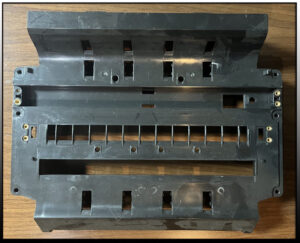The main components of conductive polycarbonate (PC) are conductive carbon series fillers and polycarbonate resin. During the injection molding process, the compound is melted after high temperature. Ideally, the carbon series fillers and polycarbonate resin are evenly dispersed, but in reality, it is difficult for these two substances to achieve this ideal situation. The mold structure and every injection molding procedure will affect the dispersion and arrangement of the two substances, which causes the surface resistivity to fail to reach the target value. To avoid excessively high, low, or unstable surface resistance in the terminal products produced by conductive polycarbonate (PC), we recommend the following injection molding techniques.
Pre-drying treatment
Conductive polycarbonate easily absorbs moisture and must be fully dried before injection molding, otherwise, the moisture will affect the conductive properties of the compound and the surface effect of the terminal product. It is generally recommended to dry at around 110°C for 3-4 hours. The specific drying time and temperature need to be adjusted according to the specific characteristics of the material and the production environment to ensure that the moisture content of the material is controlled at a low level.

Injection molding temperature setting
Control the temperature of the barrel. The appropriate barrel temperature can ensure that the conductive polycarbonate is fully melted while avoiding overheating and decomposition of the material or damage to its performance. Usually, the temperature of the front section of the barrel can be set at 250-280°C, the temperature of the middle section at 260-290°C, and the temperature of the back section at 250-290°C. Conductive polycarbonate from different manufacturers may have slightly different temperature requirements and need to be fine-tuned according to the specific material characteristics. Adjust the temperature of the nozzle. The nozzle temperature should be slightly higher than the temperature of the front section of the barrel to prevent the molten material from cooling and clogging the nozzle. It can generally be set at 260-300°C. Mold temperature has an important influence on the surface resistance and molding quality of the terminal products of conductive polycarbonate. A higher mold temperature can make the surface finish of the product good, the dimensional stability is high, and it helps disperse the conductive filler evenly, thereby reducing the surface resistance. The mold temperature can generally be controlled at 100-120℃, and the specific temperature needs to be adjusted according to the size, and structure of the terminal products.
Injection pressure setting
Properly increasing the injection pressure can make the melt of conductive polycarbonate better fill the mold cavity, and reduce the pores and defects inside the product, thereby improving the uniformity of the conductive performance and reducing the surface resistance. The injection pressure can generally be set at 800-1500kg/cm², for end products with thin walls or complex structures, the injection pressure needs to be adjusted according to the actual situation to avoid excessive pressure causing stress or other defects on the end product. The role of the holding pressure is to continue to apply a certain pressure to the mold cavity after the injection is completed to compensate for the volume change of the product due to cooling shrinkage and ensure the dimensional stability and consistency of the conductive performance of the product. The holding pressure is generally 30%-70% of the injection pressure, and the holding time is 5-30 seconds. The specific parameters need to be determined by experiments according to the actual situation of the product.
Injection speed setting
A moderate injection speed can ensure that the conductive polycarbonate is evenly filled in the mold cavity to avoid defects such as weld seams and cavitation, which will affect the conductive properties of the product. For conductive polycarbonate, the injection speed is generally controlled at 30-80mm/s, and the specific speed needs to be adjusted according to the structure and size of the product. The screw speed affects the plasticization effect of the material and the uniformity of the molten material. The appropriate screw speed can better mix the conductive filler with the polycarbonate matrix and improve the conductive properties of the material. Generally, the screw speed is set at 30-100rpm, and the specific speed needs to be adjusted according to the model of the injection molding machine and the characteristics of the material.
Mold design and mold maintenance
- Sprue design: Reasonable gate design can ensure that the molten material can smoothly enter the mold cavity and is conducive to the demolding of the product. The gate should be located at the thick wall of the product or away from the key parts of the product to avoid welds and stress concentration. The size and shape of the gate should be designed according to the product’s size, shape, and wall thickness. A larger gate helps to reduce the shear stress of the molten material and reduce the damage to the conductive polycarbonate, thereby reducing the surface resistance of the product.
- Cooling system design: A good cooling system can ensure the cooling uniformity of the terminal product and improve the product’s dimensional stability and production efficiency. The layout of the cooling water channel should be reasonable to ensure that all parts of the mold can be fully cooled. The temperature and flow rate of the cooling medium should be controlled within a suitable range to avoid differences in the conductive properties of the product due to uneven cooling.
- Mold maintenance: Regularly maintain and service the mold, check the wear of the mold, the finish of the cavity surface, etc., replace severely worn parts in time, and ensure the accuracy and service life of the mold. The finish of the mold surface also has a certain influence on the product’s surface resistance. A mold with a high finish can reduce the friction resistance on the surface of the terminal product and improve the conductive performance.




